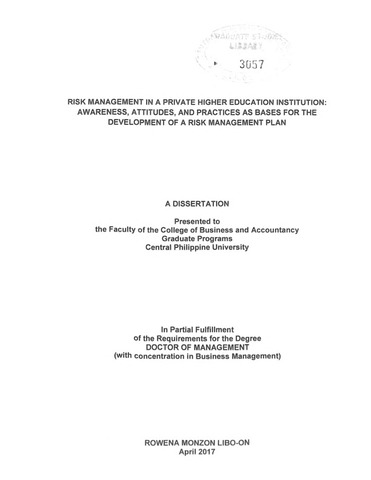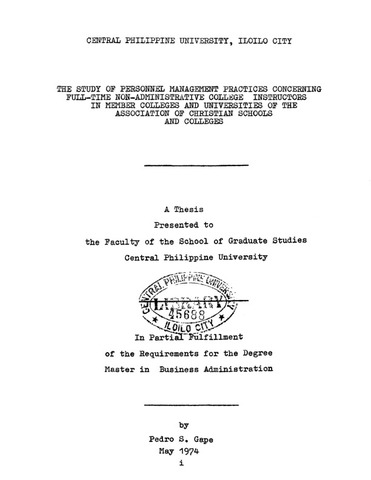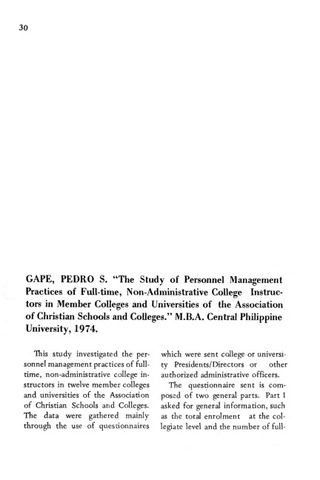| dc.description.abstract | The study was conducted in order to determine the relationship between aesthetic sensibilities and human relations skills of the deans in the eight schools in Iloilo City. The study further aimed to determine the influence of certain personal characteristics, particularly their exposure to the arts and to cultural activities on the deans’ aesthetic sensibilities and human relations skills.
This descriptive study utilized the quantitative method of research. The study was conducted in eight schools in Iloilo City, namely; Central Philippine University (CPU), University of San Agustin (USA), University of Iloilo (UI), West Visayas State University (WVSU), Colegio de San Jose (CSJ), De Paul College (DPC), St Paul College (SPC), and Iloilo Doctors ColIege (IDC). The study’s sample consisted of42 deans and 263 faculty members chosen at random from the faculty groups of the eight institutions and distributed proportionately for each dean. The data were collected using structured questionnaires.
The data collected were processed and analyzed using the SPSS for Windows Version 10.0 statistical software. Frequency distribution, Computation of means, Chi- square, Cramer’s V and Pearson Moment of Coefficient Correlation were the main statistical tools used in data analysis.
Major Findings of the Study
The college deans in the eight schools in Iloilo City were mostly between ages 46 and above, women, and married. Most of the deans had masteral and doctoral degrees. More than half of those with masteral degrees were pursuing graduate studies. The deans had an average of 23.9 years of teaching experience, most of which had been spent in the institution they were connected with. The deans had served their institutions for 10.6 years on the average, as administrators; with both female and male deans having equal number of year in the position. A little more than half of the deans were found to be teaching sciences and technology subjects. Almost 50 percent of the deans had at least average exposure to the arts. Most deans were exposed to music and reading literature, particularly the novel.
The great majority of the deans had at least above-average response to the arts. Although the association between the indicators of aesthetic sensibilities and each of the factors studied (sex, age civil status, educational attainment, etc.) was not significant, the data revealed the following; the younger deans tended to be more responsive to the arts than the older ones. Female deans tended to be more responsive than the male deans. The single deans tended to be more responsive to the arts than the married ones. Deans who had higher educational attainment (Ed DZPh.D) tended to be more responsive to the arts. The study indicates that education contributes to responsiveness to the arts.
The deans who taught humanities and language courses tended to be more responsive to the arts. The deans’ exposure to the arts was significantly related to their response to the arts. They were more responsive to music and literature than to other art forms.
The older deans tended to be more creative than the younger ones. Female deans were slightly more creative than the male deans. The single deans tended to be more creative than the married ones. Deans who taught humanities and language courses were more creative than the deans who taught science and technology courses. The exposure to the arts of the deans was significantly related to their creativity. There was significant correlation between creativity and exposure at 5 percent level. The data confirm that more involvement/ participation in the arts increases creativity.
A great majority of the deans had at least average interest in the arts. The older deans with more number of years both in the teaching profession and administrative position tended to have more interest in the arts. Female deans tended to show slightly more interest in the arts than the male deans. The married deans tended to be interested in the arts than the single ones. When grouped according to educational attainment, deans with college, masteral degrees and doctoral units showed more interest in the arts than deans with Ph.D/ Ed.D degrees. The deans, who were teaching humanities and language courses, tended to be more interested in the arts than those teaching sciences and technology courses. Exposure to the arts had a significant relationship with the interest in the arts of the deans. The dean’s interest was more in music and literature than in other art forms.
Majority of the deans had at least above average rating in human relations skills. 33 percent of the deans were rated high and 59.5 percent were rated above-average in human relations skills by their teachers.
The younger, single, and female deans tended to have better human relations than the older, married, and male deans. Since the youngest deans in the study were in the late thirties, it may be said that deans in the eight institutions were chronologically mature already. Age is significantly related to human relations skills. The study implies that the experiences and maturity one gained in life help individuals to be more understanding and adaptable to others.
Those perceived to have high and above-average in human relations skills were deans with masteral and doctoral degrees and handling humanities and language courses. Regardless of the number of years both in the teaching profession and administration, more than half of the deans had at least above average rating in human relations.
Regardless of the dean’s level of exposure to the arts, the deans were all perceived to have at least above average human relations shills. Almost all deans whether high, above average, average, below average, and low in exposure to the arts, had at least above average HR skills. This indicates that exposure to the arts does not affect the human relations skills of the deans.
The deans with high response to the arts had either above average or high rating in human relations skills. A greater percentage of deans with above average rating in human relations skills had above average response to the arts. Majority of the deans with average response to the arts had average rating in human relations skills also.
The three aspects of aesthetic sensibilities such as response to the arts, creativity, and interests in the arts were not significantly related to the deans’ human relations skills.
A great majority of the deans had at least above average aesthetic sensibilities. Women were found to be more aesthetically sensible than men. Sex is significantly associated with aesthetic sensibilities. More than one half of the deans had at least average exposure to the arts. Almost all deans with at least above average exposure to the arts had above average aesthetic sensibilities. The deans’ exposure to the arts had significant influence on their response to the arts, creativity and interests in the arts.
Conclusions
The significant relationship between exposure to the arts and the three indicators of aesthetic sensibilities such as response, creativity and interest in the arts seems to indicate that exposure enhances aesthetic experience. Involvement in and participation in the arts increase aesthetic sensibilities.
The study confirms that exposure to the arts brings understanding and enjoyment of artistic creativity. The significant relationship found between exposure to the arts and aesthetic sensibilities supports the contention of Pablo J Victoria (1976). He contends that understanding the arts help improve aesthetic life of the individual as it focuses on the ability to see, hear, smell and feel through the arts. One gains more understanding of the arts through exposure to them.
The above average response to the arts of the deans suggests that their sensitivity (awareness) must have been honed by their exposure to the arts. The fact that female deans are more responsive to the arts than the male deans reflects the former being more emotional. Since the emotion is the domain where art is more influential, responsiveness to the arts as indicated by being easily affected by the things around. This responsiveness found expression in the arts.
This statistical study has consistently shown that the deans who taught humanities and language courses tended to be more responsive to, more creative, and more interested in the arts, thus highly aesthetically sensible. While it is true that humanities and language are not the only disciplines that deal with people and their feelings (the fields of sciences and technology also do), the greater responsiveness to the arts of both humanities and language teachers may be attributed to the fact that their disciplines allow them greater freedom to express concern for people and their feelings and use a medium that gives delight not only to the senses but imagination and intellect. Humanities teachers put importance on the study of human beings and their feelings because their studies includes aesthetics/art appreciation, history, philosophy psychology, literature and other social sciences subjects. Humanities includes the study of the records of experiences, values and aspirations of people while language teaching focuses on how to express and communicate these through symbols understandable to all. Thus, it is not surprising for the humanities and language teachers to have a keen sense of appreciation for whatever is meaningful to human beings. A keen sense of appreciation is reflective of an aesthetically sensible person.
In this study, almost all deans in the eight schools were found to have at least above average rating in human relations skills. These skills include the managerial capabilities and leadership behaviors of the deans who like people, get along with them, give emotional support, and who allow them to be the best they can be in the organization.
The deans’ above average level of responsiveness to the arts, creativity, and interest in the arts in this study, suggests their keen aesthetic sense. However, data showed that there is no significant relationship between aesthetic sensibilities and human relations, thus the study could not claim that the former is a factor of their human relations. The study does not support Raaudseppe’s assertion that involvement in the arts which includes sponsorship/ production of activities or involvement in the arts hones managers perception and sensitiveness that makes them acquire a keener awareness of the business/ organizational environment.
Recommendations
The following recommendations are hereby presented, based on the major findings and conclusions of the study:
1. In view of the limitations of the research, particularly in measuring the two key variables of this study, aesthetic sensibilities and human relations, remain to be an important subject for further study. It is Suggested that a similar study be conducted using the non-academic administrators and their staff, using more precise research instruments.
2. In order to assess better the human relations skills of the administrators, human relations skills should be broken down into components such as the emotional, sociocultural, intellectual, spiritual/religious as dependent variables
3. The study has been mainly premised on the affective states of both aesthetic sensibilities and human relations. Human feelings and emotions were primary considerations in analysis of the concepts and theories used in the study. Using the same premise, aesthetic sensibilities and emotional intelligence are subject matters which can be explored. It is recommended that a study on the relationship between aesthetic sensibilities and emotional intelligence be conducted.
4. Since exposure to the arts was found to be significantly related to aesthetic sensibilities, educational administrators need to continually assess the art activities or cultural programs that contribute to further development of the aesthetic sense of their students, faculty, and staff.
5. Since creativity is related to exposure to the arts, educational institutions should encourage involvement and participation in the arts by providing opportunities for artistic enjoyment and appreciation, such as sponsorship of art exhibits and production of cultural programs on their own campuses.
6. The arts can open avenues for understanding cultural heritage, respect for artistic tradition, and patronage of national arts and culture. Educational institutions can cultivate interest in the arts by providing support and opportunities for attendance or participation in seminars, lecture-forum, or conferences on arts and culture.
7. Human relations functions help solve problems of discipline, motivation, and communication in the organization. Educational institutions can conduct regular assessment of the perception of teachers/ staff of the human relations of their college deans or department heads of the non-academic units. This evaluation will provide the deans/ unit heads legitimate information regarding how they relate with their teachers and how they conduct administrative duties which affect organizational environment. Knowing the strengths and weaknesses of the human relations of the deans will enable the higher administrators and the deans themselves to give ample provisions for the enhancement and development of their human relations skills. It is suggested that personnel offices procure standardized Human Relations Scale for administrators, faculty, and staff use. | en_US |





